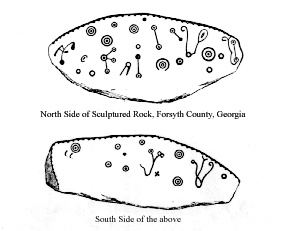
From: The History of Forsyth County Georgia vol. 1, 1985 - page 8-9
PETROGLYPH
Found near Mt. Tabor Baptist Church in the Northwestern part of Forsyth
County was described by White in 1849l4 as follows:
On the road from Canton to Dahlonega, 10 miles northwest from Cumming,
is a very remarkable rock. It is an unhewn mass of granite, eight and a
half feet long, and two and a half feet wide. It is three-sided, with irregular
converging points, upon which are characters, seventeen of them varying
in shape. The largest circles are eight inches in diameter. From its appearance,
it must have been wrought at a very remote period. The designs are very
irregular, and it is probable that they were executed by the same race
of people who constructed the mounds in this and other sections of the
State. What the characters on this rock mean, the oldest inhabitants cannot
tell. The oldest Indians could give no account of it. Would it not be proper
for the Legislature to make a small appropriation to convey this curious
relic of antiquity to Milledgeville?
Jones wrote in 1873:l5
In Forsyth County is a carved or incised boulder of fine grained granite,
about nine feet long, four feet six inches high, and three feet broad at
its widest point. The figures are cut in the boulder from one-half to three-quarters
of an inch deep.... On the eastern end of the boulder, running vertically,
is a line of dots, like drill-holes, eighteen in number, connected by an
incised line.
This boulder is now on the University of Georgia campus in Athens, Georgia,
and should be on the Forsyth County courthouse yard in Cumming. One must
agree that this pre-Forsyth County History is from the best guesses of
archaeologists and is backed up with many artifacts that have been found
in the area. Much more could have been written about the findings in this
area but maybe enough has been given to whet your desire to find out more
about the archaeology of Forsyth County.
Footnotes - Chapter I .
-
The Archaeology of Georgia, Dickens & McKinley, Frontiers in the Sail
Frontiers Publishing Co., Atlanta, GA page 12
-
Ibid - page 13
-
Ibid - page 16
-
Ibid - page 20
-
Ibid - page 30
-
Ibid - page 39
-
Ibid - page 42
-
Archaeological Survey of Northern Georgia No. 21, Robert Wauchope Society
for American Archaeology, 1966 - pp. 15-17
-
Ibid - page 394
-
Ibid - page 396
-
Ibid - page 396
-
Ibid - page 329
-
White's Statistics of Georgia - 1849 pp. 255-56
-
White's Statistics of Georgia - 1854 pp. 458-59
-
C. C. Jones, Antiquities of the Southern Indians - 1873 p. 377 & 378
From: Wednesday at the University of Georgia, April 17, 1963 - number
269 9-24
THIS BIG ROCK IS ALREADY CARVED
Late last week the plant operations department made preparations for
the arrival on campus of a most unusual gift -- a three and a half ton
petroglyph to be placed near the Georgia Museum of Art Workmen poured a
concrete slab alongside the Museum and devised a plan to bring in a lowboy
truck close enough so that the large carved stone could be lifted into
place.
The stone is coarse crystalline granite carved on both sides with symbols
and marked along its top ridge with nut-sized holes. It is about eight
feet long, three feet high, and 40 inches wide at the base. The gift of
Athens businessman Hal Vaughn, the stone is being moved here from Property
Vaughn owns in Forsyth County. Clemens de Baillou, archaeologist, says
that at first the stone was thought to belong to a later period of Indian
prehistory, or about 800 years ago. More careful study, however, indicates
that it might belong to a much earlier period. The symbolism carved on
it -- mostly double circles and some crude stick-figure bodies -- differs
from that found on stones at Etowah Mounds. The symbolism on the petroglyph
given to the University is not so rich and is perhaps a bit more primitive,
he said.
Nobody really knows much about petroglyphs, but they are associated
with fabulous tales of buried treasures. Mrs. Francis C. Smith, an Atlantan
who has spent much time hunting petroglyphs in Georgia, reported in a 1950
issue of "Early Georgia" that many treasure seekers had thought there were
40 pony loads of pure Indian gold under this very petroglyph.
If it ever had a golden base, the University's "new" carved stone has
come to a prosaic end. It will rest now on concrete. Incidentally, this
is not the University's first petroglyph. There is another smaller one
in the enclosed garden at the Law School .
Home Ascending
Rocket